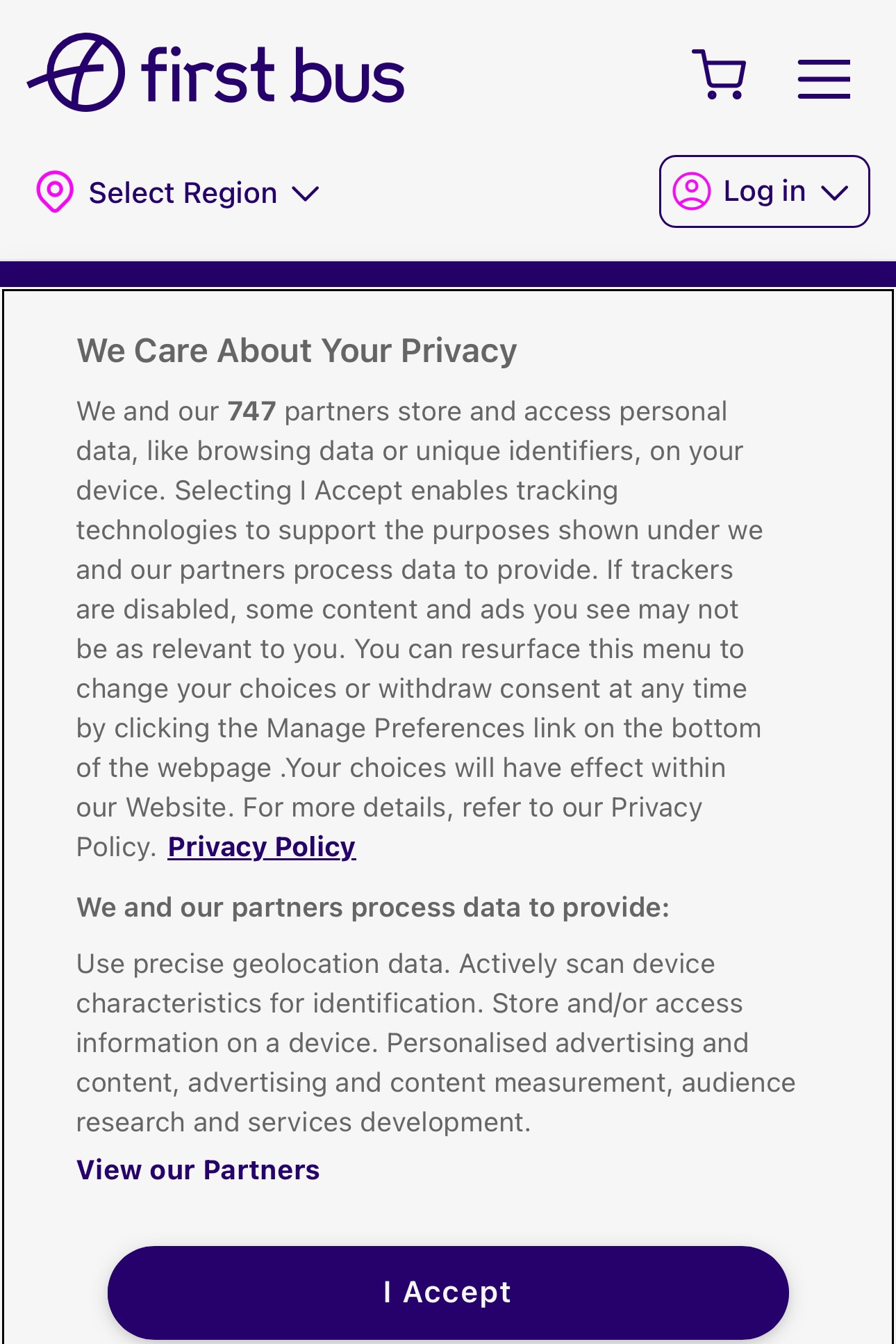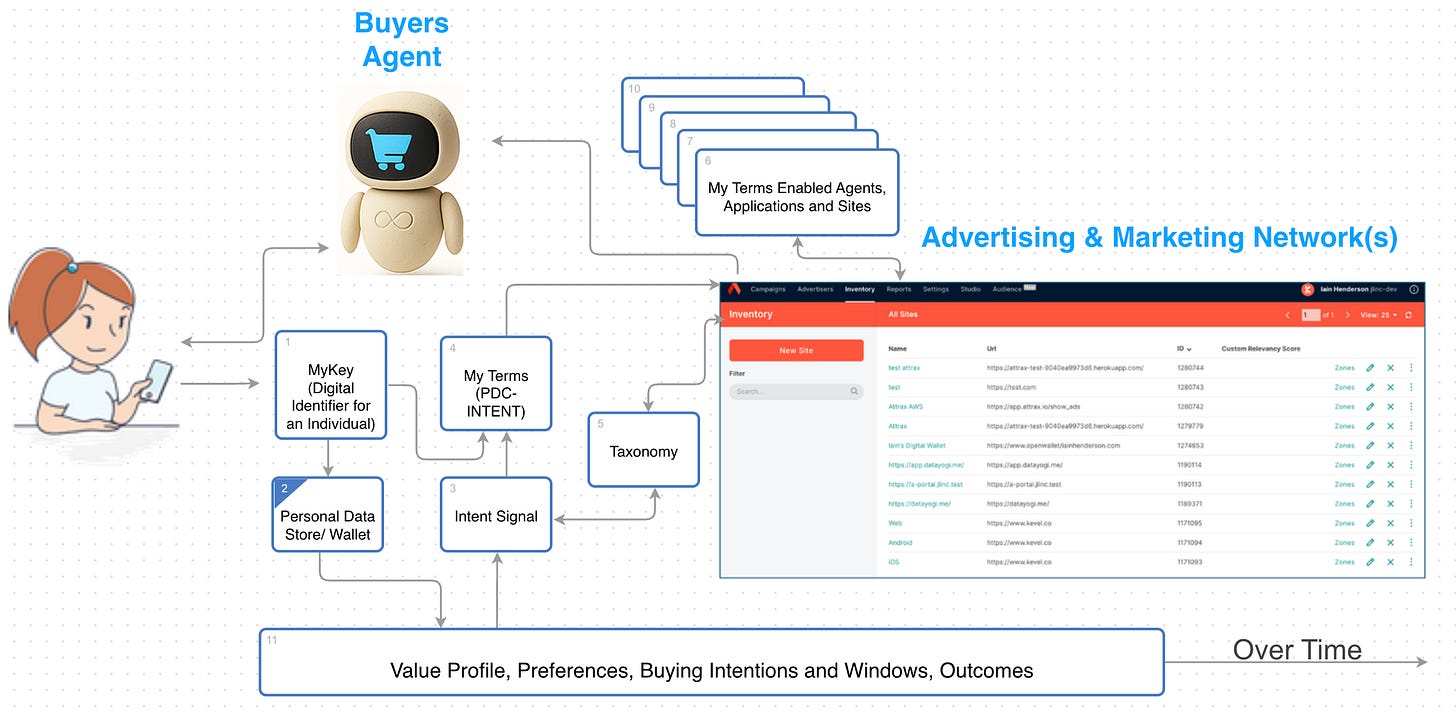Re-inventing Digital Advertising and Marketing with ‘My Terms’
New possibilities with IEEE7012 (aka My Terms)
Once upon a time, many years ago, my first degree was in Marketing - from University of Strathclyde in Glasgow. That pretty much shaped my entire career as every role I’ve had since then has been something in or around the marketing discipline. I have always been on the science side, rather than creative; so very quickly (1988) I got into direct marketing, which became database marketing, then CRM, then e-Commerce then ‘social’ and now ‘AI’ and agents.
Why am I telling you all of that? Quite simply, because I think it that discipline (digital advertising and marketing) is very broken right now, and has the opportunity to re-invent itself. And that will be a very good thing for all parties willing and able to embrace the change…
What does that mean?
I always remember the definition of marketing that was presented on the first day of that degree. It was ‘marketing is the process of listening to your customers, understanding their needs and wants and planning to help them meet them - at a profit.’
Obviously there are some nuances to that definition that one could question; but in the main I think it was valid. Or at least it was until the late 1990’s. At that point The Internet emerged as a commercial platform. We stopped listening, and started spying. From that point on we have been ‘data driven’, build profiles, drop cookies, do things programmatically and increasingly see big tech providers inserted in the middle of our customer and prospect relationships.
And because of that data and surveillance addiction, marketing and advertising is a compliance and customer experience nightmare. I mean all those cookie banners, consent management platforms and checkboxes to confirm the customer has read, understood and agreed with our terms and conditions when very clearly they have not and do not.
All to what effect? I have my doubts. The first direct marketing campaign (1988) I was involved in got 1% response and 1% of 1% conversion (i.e. people who bought the thing being promoted as a result of the campaign). I ran another one last year - the same proportions came back, despite the vast increase in data availability and fancy profiling and communication options. (the underlying point being that with some decent targetting
So, here’s my hypotheses… It’s time to move beyond the spying and shouting; and go back to a model in which ‘listen and respond’ under an overall brand/ proposition is the main tactic. That is to say, build a new approach that moves beyond the current surveillance based model.
And we have a new tool in our kit-bag that can help us do so…. My Terms…
My Terms, also known by its more formal name IEEE7012, is a draft Internet standard through which individuals can propose the terms under which they share their personal data from a series of standard agreements - as opposed to accepting terms that are proposed by the organisation that is asking for data to be exchanged. My Terms will have many implications over time; but for now let’s focus on its potential early impact on enabling new ways to approach digital advertising and marketing.
There is one specific agreement that is designed for the advertising and marketing scenario. It’s called ‘PDC-INTENT’, or ‘Personal Data Contribution relating to Buying Intentions.
We all know only too well the scenario that the PDC-INTENT agreement is designed to counter:
1. We want or need to buy something online, and show up on a web site or app to do so. We might buy, we might not; the end result is the same - our intentions trigger the marketing and advertising surveillance machines into action and we get bombarded with pop-ups, offers, follow-up emails, and ‘related’ adverts that follow us around for a week or two. Irrespective of whether we have bought the thing or not. Often we have, in which case every advertiser pushing ads or marketing in my direction is wasting their money and my time/ perception of them.
2. Or if we happen to be buying something from a new supplier we get the whole ‘consent’ mechanism. Check out the one below from the Glasgow bus company that just cracks me up. Yes, ‘we and our 747 partners value your privacy’… Has the world gone mad? I think it has. How can we build a whole economy on asking people to check a box to confirm we have read, understand and agree with the terms and conditions and privacy policy when we have done none of that?
Here’s my thesis on what we can do about that.
Firstly I’d rule out, for now anyway, thoughts on building a new approach to advertising and marketing that integrates nicely into current models. I’ve looked at that before and there are some approaches that would enable human-centric approaches to flow data into ‘the bid stream’, aka the ‘real time bidding’ mechanism that sits behind current approaches to advertising. But they are pretty complex; so let’s put those aside for now.
I think we need to, and can, build what Rory Sutherland pointed to a few months back - an approach that reverses the current polarity of current approaches. One in which the customer, or their agent, surfaces their intent (buying interest/ need/ want) in ways that is safe for them, but which also sends meaningful, detailed and actionable signals to the market place that they are in the market for some product or service.
My Terms is part of that; but not enough in and of itself. I think we also need:
- Tools that give people genuine agency on The Internet, for example strong digital identifiers that people create, control, and manage themselves
- AI powered ‘fiduciary’ agents acting on their side; people are not likely to wish to engage in boring, automate-able processes; but would outsource those to software agents if they could be trusted to be on the person’s side.
The obvious challenges:
- How does one advertise or market to an agent; i.e. a piece of software?
- How do advertisers and marketers engage in this new ecosystem when they are optimised for the current model?
- How do we get people to even care about advertising and marketing rather than be somewhere between pet hate and ignored in the main; with the very occasional high spot.
Firstly, I’d start with building a prototype/ proof of concept. We’ve done that. The visual below shows what we built. It uses FedID as the strong, unique digital identifier (*) that represents an individual (or a context/ role the individual has), DataPal as the personal data store/ wallet, a software agent that maintains a person’s advertising preferences and requirements based on the data they control, an open banking data-set as a main feed into the ecosystem, My Terms/ PDC-INTENT as the means to share data under a contract, Curated Audience taxonomy as the means through which individual preferences and requirements are expressed externally, Kevel as the ‘ad network in a box’, and Salesforce CRM and marketing Cloud to cover digital marketing scenarios. Most latterly we have been tinkering with Model Context Protocol (MCP) as the means to share data from an individual/ customer-side agent with an equivalent MCP server and clients on the front of the advertising network.
(*) Adtech and martech stacks love digital identifiers of people; cookies for example are such. The one we use has fantastic inherent capabilities (FedID is a branch off of Open ID Connect which is what powers social login). It just so happens this identifier is created, managed and controlled by individuals; and prohibits surveillance.
Having studied our PoC in detail, I think the best way to understand it is to look from that individual perspective - not from the publisher, brand or adtech/ march provider view. That means seeing advertising and marketing more akin to an information service for individuals that is uniquely tailored, by them, to their needs, wants and preferences; and not as a means to generate revenue. That means ‘I get relevant communications about things I have, things I want and potentially things I may want but don’t know about. The critical aspect of that is obviously the definition, data and methods that underpin ‘relevant’. There is also then the issue of ‘channel’. Logic would suggest that information services should show up at close to point of use as possible. Historically that has mainly been a media buying challenge; but what about that scenario when the customer is coming to market via a buyers agent? Does the agent need a rate card? And what about sellers agents? It’s very clear now that organisations and applications are all going to want to/ have to ‘agentify’ their customer-facing properties.
Despite the undoubted complexities in any new model; I think the ‘fresh start’ direction offers some real upsides. And no real downsides other than the uncertainties of adoption. There are no compliance headaches, no consent pop-ups, no ad blockers, and no spam blockers. Just people sending things to people who want to receive them. Fraud is difficult to envisage; but can never be ruled out. But in this governed ecosystem we have cryptographically verifiable parties talking to other cryptographically verified parties about areas of mutual interest, an audit log and the ability to build reputation mechanics. Sure, fraudsters might ultimately get themselves a quantum computer and break the cryptography; but when they do that there will be many easier ways to make money than to break into the above…
I think this will boil down to numbers. How many people engaging with this model will it take to make it of interest to advertisers and marketers? And in what sectors? Automotive? Travel? Buying Property? Technology? Retail? I can make an argument for any of those and a lot more. We won’t know until we try, so we are now looking for brands, advertisers, publishers and adtech/ march providers that are interested in running proofs of concept with this new ‘empowerment tech’ based and ethical model.
Next up…., how does one advertise or market to an agent anyway?





